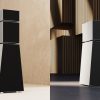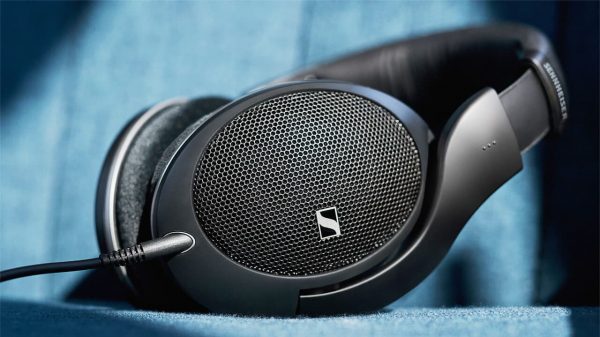It takes a certain kind of craziness to become a headphone manufacturer in 2022. One could argue that with so much room for long-term growth, how could one not make money developing and manufacturing consumer headphones? Ask the folks at Sennheiser who sold off their consumer headphones division last year if it’s all strudel and coffee in that regard.
Apos Audio’s primary focus is the retail side of the business but that hasn’t stopped them from collaborating with headphone manufacturers and creating products like the Apos Caspian Headphones which we previewed in August 2022.
Getting into the headphone market right now is fraught with all kinds of risk and after a recent conversation with one of the brands that has benefitted enormously from the exponential growth of the market and sold thousands of DACs and headphone amplifiers in the process — it’s not something that they have contemplated for even one second.
Just because you can, doesn’t always mean that you should.
On the other hand, the margins can be pretty good for boutique headphone manufacturers, but are very small when it comes to the larger mass market products, and finding a way to distinguish your new product in an ocean of headphones is very difficult.
Brands like Audeze realized this a few years ago and started developing other products utilizing their technology for other markets like the medical world and office conference speaker systems.
The market for $4,000 headphones is remarkably small and it’s why brands like Grado Labs who sell thousands of high-end headphones every year has kept its focus on affordable models and its very successful phono cartridge business which pays the bills every month.

From Russia with Love?
In order to mitigate the risks and improve their chances of success, Apos Audio partnered with Sandu Vitalie of Soundnews to help tune their new headphone, and with Kennerton Audio; who are based in Russia for help with the design and construction.
Kennerton Audio’s own line of headphones runs from the Jord ($350) up to the Rognir (read our review) and Thror ($3500) with several stops along the Trans-Siberian Railway giving them some level of expertise when designing headphones for the upper end of the market. The Rognir is one of the most impressive products in the ultra high-end headphone category and should be considered with the best from Meze Audio, Audeze, and Dan Clark Audio.
Sandu founded Soundnews and has been listening and writing about audio gear for quite some time now and had some definite ideas about what he wanted in a headphone; Apos also had a very specific price point that they wanted to target and the reached out to Kennerton. From this collaboration, we ended up with the Apos Caspian Headphone that is under review this week.
I’m sure some will raise an eyebrow at the idea that a publication is getting into the “manufacturing” side of the business but how is that any different than publications like Gear Patrol who do product collaborations with Huckberry and a lot of outdoor product manufacturers?

Nobody forces you to buy anything and you are being informed about the conflict in advance.
The Skinny
Those familiar with the Kennerton family of headphones will recognize some of the features from their other models fairly quickly. The headband is pure Gallahorn GH, the cups and cable jacks are from the Vali, and the wood is similar to the Magni or M12 Dusk.
The cable and case are also typical of Kennerton offerings. The areas where the Apos Caspian differs from most of the Kennerton line are the driver which is unique to the Caspian and the cup design which shares elements of the Vali and Magni, but is not a duplicate of either.
The ear pads are hand-sewn leather and again similar to other Kennerton models and one of the better made memory foam pads available in my personal experience.

For those less familiar with the Kennerton line, the Caspian has a steel headband with a padded leather wrap and stamped gimbals with adjustments similar to those used by Beyerdynamic or Sennheiser.
The ear cups are aged oak with a large grille finished with the Apos logo in matte black that matches the gimbal/headband. The connectors are 3-pin mini-XLRs on each cup with a slight forward angle.

Overall, the Apos Caspian has a dark wood and flat metal aesthetic that gives it a very businesslike appearance. The 380 gram weight puts it near the middle of the pack; the HiFiMN HD6xx weighs closer to 200 grams and the HiFiMAN HE6 tip the scale at nearly 700 grams.
The Kishkas
Internally, the Apos Caspian uses a 50mm dynamic driver with a graphene coated low-mass diaphragm. The driver is then mechanically decoupled from the frame to help lower distortion; it has been tuned to deliver a polite sonic signature with some intentional filtering of the top end between 2 kHz and 7 kHz to reduce listener fatigue.
Can you drive these with your iPhone or a Dongle DAC?
The nominal impedance is listed as 33 ohms with a sensitivity of 115dB/mW. My measurements showed an impedance of 37 ohms at 1 kHz and a sensitivity of 116dB/mW at the same frequency (±3dB).
This puts the Caspian in the class of headphones that can easily be driven by a Dongle DAC or tablet; but I would add that it doesn’t require one from a power perspective.
The Caspian will scale some qualitatively with better sources but it simply does not need the additional power most amps provide.

I found it odd that a headphone that was designed to work using a Dongle DAC, phone, or tablet does not come with a cable compatible with any of them.
The stock cable is a 6.35mm single ended cable and the Apos Flow cable that was provided as an upgrade is 4-pin XLR to mini-XLR for in home use and the other options for the Flow cable do not include a 3.5mm single ended jack.
The Caspian seems a bit schizophrenic as it is designed for use with portable source gear but neither the open back design nor cable options are particularly suitable for that use case.
Luckily, mini-XLR to 3.5mm cables are not all that uncommon and I had more than one in my possession so I was able to test the Caspian using both desktop gear (Questyle CMA 15 and RME ADI-2) and portable gear (Kann Alpha, WM1A, and Dethonray DTR1).
The Sound of Music
I had initially tried the Caspian with the RME ADI-2 using it as a DAC and the Xduoo TA-26 amplifier but found it to be a poor pairing as both the amp and headphone add warmth to every recording and the overall presentation became too thick and lacking in detail.
Moving to the ADI-2’s headphone output resulted in a a cleaner sound with a much higher level of transparency and detail; the Questyle CMA15 also performed similarly with good dynamics and without adding more colorations to a headphone that definitely requires some sunlight if you really want to hear what it can do.

On the low end, the Caspian delivers good bass extension and impact without sacrificing clarity in the process. I have to say I’m impressed with the amount of bass impact the Apos Caspian delivers for an open-back design as it borders on “bass-head” territory which is usually an area where closed back designs rule.
The bass does roll-off somewhere in the lower 20Hz range; there is more than enough impact with music, movies, and video games and an ample amount of texture.
The mid-bass offers some degree of emphasis; I would not call the Caspian neutral sounding in this particular area but the overall levels of transparency and texture are not diminished by it. There is definitely some mid-bass bleed which is something that I expected considering how strong the deep bass is with almost every genre of music.
The lower midrange has good note weight and energy which definitely moves the Caspian outside the norm and away from the Harman target; it would be fair to describe the Caspian are quite linear sounding in this area and that’s a really important characteristic especially with orchestral and string quartet pieces.
The combination of strong bass response, midrange energy and resolution really brought a number of classical pieces to life; the dynamics on the “1812 Overture,” and “The Great Gate of Kiev” were impressively reproduced and I found that strings had excellent timbre and decay.
When a headphone makes strings really sound that natural, it’s hard not to notice and want to continue listening.
There is an upper midrange lift that brings female vocals forward in the mix and gives violin a nice upper range without becoming brittle or steely sounding.
Listening to rock guitar tracks highlighted a few things; the Apos Caspian can be very impressive in terms of its tonal balance and midrange resolution, but it also rounds off the edges which could lead some to think that rock music will sound slightly dull. I do wish there was a bit more detail here in that regard.
Moving from the upper midrange into the lower treble the tonal balance remains fairly balanced and there isn’t much a change with the presentation. Above 6 kHz, there is a degree of roll-off which prevents the Caspian from ever sounding bright; the trade-off is a lack of air or sparkle that robs cymbals of some of their energy to sound more realistic.
The Caspian does respond well to some EQ between 6-8 kHz and I felt that the headphone responded best overall with source equipment and headphone amplifiers that were on the more neutral side. Darker sounding sources will come across as quite dull and lacking in detail through these headphones.

The tonal balance of the Caspian has a rather significant impact on the soundstage; there is more depth than width, but I felt that the warmer tonal balance created the impression that there was much less than was actually present.
Everything sounds quite natural; a small club or large auditorium are faithfully reproduced but the tonal balance diminishes what could be one of the Caspian’s best attributes.
Instrument separation is good in the upper registers but can have a small degree of overlap in the lower. Every instrument occupies its own space within the soundstage but it’s not as carved out as other headphones in the category and I did detect a small amount (tiny) of compression when listening to some very complex material.
Conclusion
Who exactly should consider the Apos Caspian Headphones?
With a tuning that is rather warm and slightly thick, I would honestly suggest that it is better suited for headphone listeners that are using it with more neutral sounding or even bright source components or headphone amplifiers.
Is it for the Head-Fi folks who want to conduct a critical listening session every single time they put them on? Not really.
The cable choice is odd considering that its impedance and sensitivity rating make it almost ideal for portable source gear. I do think you will achieve better sound quality using a dedicated headphone amplifier and balanced cables if this is going to be a daily driver.
The build quality is quite good and the overall attention to detail and finish is quite appropriate for the asking price.

But is it different enough from the other models in the Kennerton lineup to warrant a look if you already own their M12 or Magni headphones? At $499, it faces a lot of competition from HiFiMAN, Sennheiser, and Meze Audio.
If you’re looking for a neutral or overly detailed sounding pair of headphones, the Caspian won’t be your cup of tea.
But for those of you looking for a very pleasing sounding pair of headphones and have the right sounding headphone amplifier or Dongle DAC, the Apos Caspian might be exactly what you’ve been searching for.
Where to buy: $499 / $599 at apos.audio (without/with Flow Cable)






































